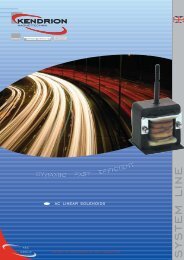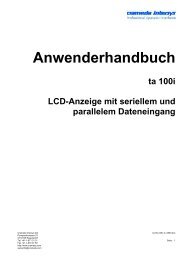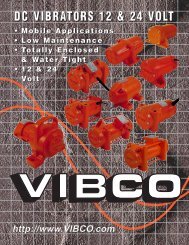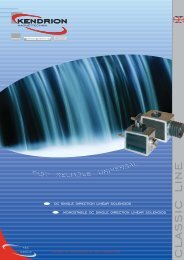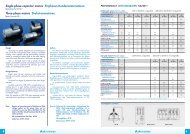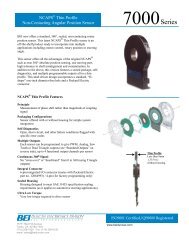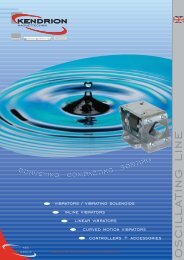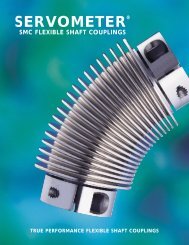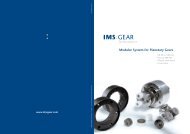External Concrete Vibration - Bertda Services
External Concrete Vibration - Bertda Services
External Concrete Vibration - Bertda Services
- No tags were found...
Create successful ePaper yourself
Turn your PDF publications into a flip-book with our unique Google optimized e-Paper software.
MEDIUM TO LARGE FORMS<br />
PNEUMATIC PAGE DECIBELS FORCE OUTPUT<br />
CCL-4000, CCF-4000, CCW-4000 6 & 7 78 dB 4000 lbs.<br />
SVRLS, SVRFS, SVRWS-4000 6 & 7 78 dB 4000 lbs.<br />
SVR-4000 6 & 7 82 dB 4000 lbs.<br />
CCF, CCL-5000 14 & 15 78 dB 5000 lbs.<br />
SVRFS, SVRLS-5500 14 & 15 98 dB 5000 lbs.<br />
CCF, CCL-7000 14 & 15 78 dB 7000 lbs.<br />
ELECTRIC PHASE PAGE FORCE OUTPUT<br />
2P-800 1 & 3 phase 16 & 17 1700 lbs.<br />
2P-1700 3 phase 16 & 17 2500 lbs.<br />
2P-2500 3 phase 16 & 17 3500 lbs.<br />
2P-3500 3 phase 16 & 17 4500 lbs.<br />
2P-4500 3 phase 16 & 17 5500 lbs.<br />
2P-5500 3 phase 16 & 17 6800 lbs.<br />
The 115-volt “plug-in” electric models US and USL are popular for small to medium forms when compressed air is not always<br />
available or on job sites where generators can be used.<br />
The larger 3 phase models – 2P-800 and up – are used for permanent mounting on concrete pipe forms and vibrating tables.<br />
The pneumatic vibrators are by far the most popular ones, they are low cost, lightweight, easy to mount to any bracketry, and<br />
easily repairable by the mechanic on the job site.<br />
The pneumatic turbine lines VS, CCF, CCL and CCW are the most popular for the small to medium size forms, because of their<br />
noiseless operation, noise as low as 72dB at high frequency and light weight . They are pre-lubricated for life so no lubrication is<br />
necessary.<br />
FOR THE LARGER FORMS<br />
The larger CCF, CCL-4000, -5000, and -7000 are used for larger forms. They are quiet, high force, and no lubrication is required.<br />
These units are also excellent for self-consolidating concrete.<br />
The SVR line of high frequency vibrators can produce as high as 15,000 VPM, which is ideal for obtaining a smooth architectural<br />
finish. The standard units have frequencies of 8,000 to 12,000 VPM for fast placement and producing strong, void-free finishes.<br />
These units must be continually lubricated to maintain their speed and force output.<br />
F. <strong>Vibration</strong> procedure and vibration time.<br />
1. <strong>Vibration</strong> Procedure: Place vibrators to be used in their lowest position. It’s a good idea to pre-mark the vibrator<br />
position. Do not start vibrators until the concrete reaches them or is no more than 6” above them.<br />
TIP: If internal vibrators are used, do not start the external ones until the internals have stopped or moved to a higher position. The reason for this<br />
is, internal vibrators throw air bubbles away from the vibrator head against form side leaving air holes and pockets on the surface. <strong>External</strong><br />
vibrators throw air bubbles into the mix, up and out, leaving surface against form smooth and blemish free.<br />
2. How long to vibrate Some experimentation on the customer’s part is always necessary because the time you need<br />
to vibrate varies depending on concrete slump, additives, stiffness of form, vibrator force, etc.<br />
Do not start the lowest vibrator until the concrete reaches them or is no more than 6” above. The concrete stiffens the form and if vibrated earlier,<br />
the vibration might move the form, making it flex, promoting leaks and seepage.<br />
a. If there is only one vibrator on the side of the form, keep it vibrating until the form is full and no more air bubbles<br />
are breaking on the top of the concrete and a glistening surface appears.<br />
b. If there are multiple vibrators per side, keep the lower vibrator running until the concrete pour reaches the higher<br />
vibrator – then stop the lower one, start the higher one and let it vibrate until the pour is complete and no more<br />
bubbles break on the surface of the concrete and a glistening surface appears.<br />
G. Helpful hints and corrections after you strip the form (please see page 27 under septic tanks).<br />
H. Additional Tips<br />
1. Metal forms transmit vibration far more effectively than wood forms.<br />
2. Always stiffen up forms to avoid distortion and flutter and for best vibration transmittal to concrete.<br />
3. Rest forms on wood beams or rubber mats to avoid vibration transmittal to floor and surrounding forms, as well as for<br />
quiet operation and increased vibration amplitude and uniform compaction.<br />
4. <strong>Vibration</strong> time depends on height and structure of form. Vibrators should be operated until a flat, glistening surface<br />
appears and no more air bubbles burst on the surface.<br />
5. <strong>Concrete</strong> of proper consistency is not susceptible to over vibration and segregation. If segregating occurs, reduce<br />
slump, not vibration time and tighten form joint.<br />
Our experience has been to see “under-vibration” rather than “over-vibration” due to too short vibration time or force, to get a<br />
homogenous, air-bubble-free mix.<br />
PHONE: 800-633-0032 • www.vibco.com • FAX: 401-539-2584<br />
19



